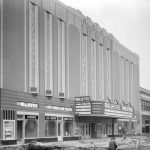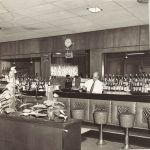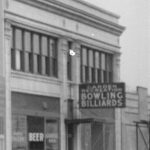
When John Bauer and Irv Giese first opened The Garden Bowl (Garden Bowling Alley c: 1913) on August 1, 1913, there were 10 lanes on the first floor, and a billiards room appointed with a grandstand to accommodate high-profile pool tournaments on the second floor. In those days pin setters, who resided in flophouses on Michigan Avenue’s skid row, set pins by hand using pegs coming out of the center pin spots activated by a foot switch. It was home to some of the first Bowling Proprietors Association of America meetings, with Mr. Bauer serving as the association’s first executive director. in present day, The Garden Bowl is among the oldest operating commercial alleys in the country and the edifice itself is listed in the National Registry of Historical Places. If The Garden Bowl lanes could talk, their story would tell of entire generations sweeping over Midtown Detroit and landing safely in the surrounding suburbs. They would speak of the rise and decline of auto manufacturing in the Motor City, and they would go on and on about the people that have kept the spirit of fun alive on Detroit’s main street.
The Garden Recreation, as it was primarily known as, was a Motor City hot spot in the 1920’s and part of the 1930’s. Originally there were storefronts on Woodward Avenue and a hallway that led to the bowling lanes behind the stores. The building was renovated in 1926 by adding space on the second floor to accommodate 12 more lanes and the grandstand that surrounded the billiards area was removed. The billiards aspect was lost to the new Detroit Recreation on Lafayette Street. Like The Garden Recreation, it too was quite a place; a working man’s country club boasting four floors with 22 lanes each and four floors of billiards.

The area of Woodward Avenue where The Garden Bowl is located, affectionately known as Midtown, used to be packed with people. They used public transportation such as streetcars and the neighborhood had plenty of SRO’s (single resident occupant hotels) like the one across the street from The Garden Bowl, known then as the Strathmore Hotel. At that time, the auto industry was in full bloom and people from as far away as Flint would take the train to Detroit, get off at the E. Grand Boulevard station and take a cab to work on Monday mornings. They would team up with others to share a single room and a quarter would give them use of a shower and a towel and soap. These folks would leave for their homes after work on Fridays via the train, but while they were in town, they would use The Garden Recreation as their place to eat three meals a day, socialize at the bar, and bowl several nights of the week.
Bowling has always created opportunity for wager and The Garden Recreation of the 1930’s was no exception as major jackpot bowling took place there on a weekly basis. Groups of bowlers would come to Detroit and line up jackpots to challenge the locals. Many times the out-of-towners would require a  neutral bowling center for the match, and most likely it would be The Garden Bowl. Bowling sensation and Detroit resident Joe Norris (named a Top Ten Bowler of the Century by Bowling Magazine) once revealed to Joe Zainea, whose family has owned the historic bowling alley since 1946, that he had the biggest wins of his career on lanes 13 and 14.
neutral bowling center for the match, and most likely it would be The Garden Bowl. Bowling sensation and Detroit resident Joe Norris (named a Top Ten Bowler of the Century by Bowling Magazine) once revealed to Joe Zainea, whose family has owned the historic bowling alley since 1946, that he had the biggest wins of his career on lanes 13 and 14.
It was the early 1940’s during a card game with his friends when Joe Zainea’s father Al, first learned of the availability of the recently foreclosed upon Garden Recreation. He eventually bought the building in 1946 and began to carry on the tradition of making the site a playground for Detroit’s working class. As more and more people began to settle in the surrounding neighborhood, The Garden Recreation was filled with leagues like office groups, unions, fraternal groups, and house leagues. Leagues like the Detroit Free Press All-Stars bowled on Thursdays and the Detroit Women’s All-Star Classic bowled on the second floor on Tuesday nights. A reminiscent Joe Zainea recalls leaving The Garden Recreation on Friday nights with his father and seeing the same bowlers on Saturday morning when he returned with his brothers to bowl in their youth league.
In the 1960’s, there were 35 bowling alleys within two miles of Midtown, but none quite like The Garden Bowl. It was truly a workingman’s clubhouse staffed by lively Detroiters like Henry, the club’s notorious counterman. He was a concessionaire and the perfect gentleman’s gentleman, complete with a smock,  and a small leather bow tie. He reserved your bowling ball behind the counter for you for when you arrived to bowl. He checked your coat and had ready your special cigar rolling on the machine. He would brush your coat and hang it up, rent you bowling shoes and polish yours. He would sometimes clean and block your hat while you bowled, and then, of course he would book your numbers and horses. In this manner, he put all of his children through college.
and a small leather bow tie. He reserved your bowling ball behind the counter for you for when you arrived to bowl. He checked your coat and had ready your special cigar rolling on the machine. He would brush your coat and hang it up, rent you bowling shoes and polish yours. He would sometimes clean and block your hat while you bowled, and then, of course he would book your numbers and horses. In this manner, he put all of his children through college.
In 1966, the Zainea family bought the building to the south of The Garden Bowl and tore down the walls between the two structures to make room for new restrooms and six more lanes, bringing their total up to 28. They also added some cutting-edge upgrades including under lane returns, new masking units, and new automatic pin setters. As the Zainea family began to grow, so did the need for more income and Joe, along with his brothers, established Detroit Bowling & Trophy. They made trophies in the basement of The Garden Bowl and sold them in a small store in the front on the main floor. The business grew so fast that they bought the corner building to the north, made the trophies on the second and third floors, and again made a very pleasant storefront on the main floor. Still this wasn’t enough space for making their goods so in 1984 the brothers rented, and eventually bought, The Majestic Theatre building to expand their production.
In 1992, with Joe and his two sons, Dave and Joe Jr. now at the helm, the suspended ceiling and eight lanes were removed from the second floor. A dance floor and 10 pool tables were added in their place and the area was called The Magic Stick. “It resembled a rich man’s recreation room in his basement,” said Joe Zainea of the now legendary rock room. “It took off quickly and a year later we removed the remaining four lanes to expand the dance area. We revamped The Majestic Theatre next door and built The Gnome Restaurant, now named The Majestic Café, and that is where we are now.”
four lanes to expand the dance area. We revamped The Majestic Theatre next door and built The Gnome Restaurant, now named The Majestic Café, and that is where we are now.”
The crowd at the bowling alley, continually shifting through the decades, now consists of young people who live in the many lofts in the area and/or attend one of the colleges located in Midtown Detroit. They have discovered a new and fun thing to do with their free time: Bowling. Not quite like it was in the days of the burgeoning auto industry, but with the lights off, spinning mirror balls, smoke machines, lanes glowing in the dark, and a live DJ spinning their favorite music, Rock-N-Bowl makes for a great night out. The lanes themselves have been recently upgraded to an AMF sanctioned synthetic material and on any given night are still buzzing with the sound of Detroiters enjoying the game of kings and working men alike.
*The Garden Bowl is a division of Majestic Theatre Center, Inc., which includes The Majestic Café, The Majestic Theatre, The Magic Stick, Sgt Pepperoni’s Pizzeria and Deli, The Alley Deck, and of course the Garden Bowl (aka the Rock-N-Bowl). “A City Block of Fun and Dining on Detroit’s Main Street.”
